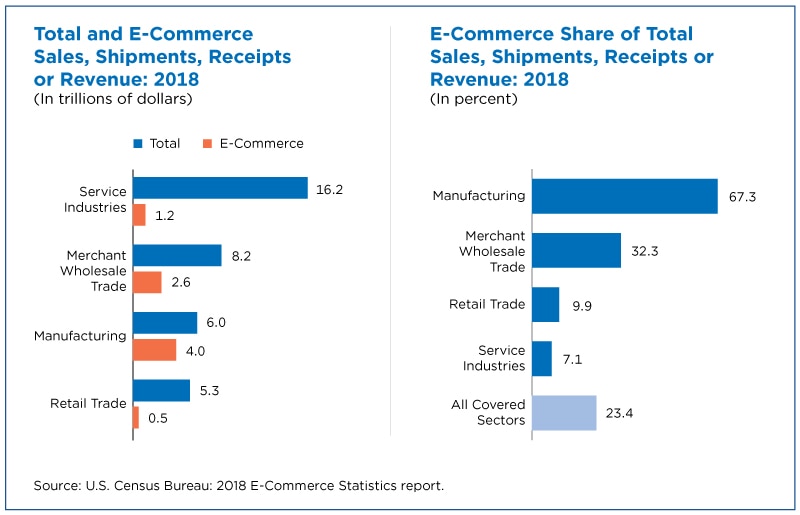Ask someone to define “e-commerce” and they’ll likely say: online shopping.
While online retail certainly is a significant player in the world of e-commerce — $519.6 billion of total retail trade e-commerce in 2018 — it pales in comparison to the share of total manufacturing, wholesale trade and services sector activities conducted electronically.
Manufacturing businesses have embraced e-commerce because it streamlines the process of purchasing and selling components and products to other businesses.
According to the Census Bureau’s 2018 E-Commerce Statistics report, manufacturing e-commerce shipments made up 67.3% or nearly $4.0 trillion of the $6.0 trillion in total value of manufacturing shipments.
By comparison, retail e-commerce sales were only 9.9% or $519.6 billion of the $5.3 trillion in total retail sales.
E-commerce made up 23.4% of the total sales, shipments, receipts or revenue of all four sectors covered in this e-commerce report.
The share of manufacturing e-commerce shipments climbed steadily for nearly two decades.
In 1999, e-commerce accounted for $729.6 billion (18.1%) of the $4.0 trillion total value of manufacturing shipments. By 2018, this share had risen to 67.3%, growing even in 2002 and 2009 when the total value of manufacturing shipments and e-commerce shipments declined.
What Is Manufacturing E-Commerce?
Just like the retail trade sector, Manufacturing e-commerce includes online orders from customers. However, these orders include purchases from both traditional consumers and other domestic establishments of the same company that in turn manufacture, assemble or fabricate the product.
For example, electronic orders of components by an automobile assembly plant from a parts manufacturer owned by the same company would be counted as manufacturing e-commerce.
E-commerce can be conducted over the internet but also includes sales made using extranets, Electronic Data Interchange (EDI) networks, email or other online systems and payment may or may not be made online.
The price and terms of manufacturing e-commerce shipments can also be negotiated on these platforms.
Manufacturing businesses have embraced e-commerce because it streamlines the process of purchasing and selling components and products to other businesses.
The automobile assembly industry is a prime example.
The industry adopted “just-in-time” manufacturing years ago. Under this process, components needed to build cars are delivered to the assembly plant right when they are needed. This helps reduce the need for large parts inventories and warehouse space to store them.
To make this process efficient, the assembly plant maintains an electronic data interchange with parts suppliers to order parts exactly when they are needed.
Does E-Commerce Rule in all Manufacturing Industries?
While Transportation Equipment Manufacturers, which includes automobile assembly plants, led the manufacturing sector in e-commerce shipments in 2018 ($826.8 billion), other manufacturing subsectors reported high e-commerce shipments as well.
Food Manufacturers reported $519.0 billion in e-commerce shipments in 2018, closely followed by Chemical Manufacturers with $514.5 billion.
While some manufacturing sub-sectors dominate e-commerce, nearly all of them saw increases in e-commerce shipments between 1999 and 2018.
E-commerce shipments in Paper Manufacturing, for example, rose 66.2% from $15.3 billion in 1999 (9.8% of total shipments) to $145.1 billion in 2018 (75.9%), the largest percentage increase of any manufacturing sub-sector.
Only two sub-sectors saw e-commerce shipments dip during the same period. But even then, the e-commerce share of their total shipments increased.
For example, e-commerce shipments of Leather and Allied Product Manufacturers decreased by $190 million (-8.1%) between 1999 and 2018. Yet e-commerce made up a much larger share of total shipments: 47.4% in 2018 compared to 24.2% in 1999.
Similarly, e-commerce shipments of Apparel Manufacturers decreased by $11.4 billion (-69.2%) between 1999 and 2018, but the industry’s share of e-commerce shipments increased from 26.5% to 51.4%.
The Future of E-Commerce in Manufacturing
Manufacturers embraced e-commerce for some of the same reasons as the wholesale and services sectors: It allows them to simplify business processes and streamline relationships with downstream customers and upstream suppliers.
Businesses that supply inputs to manufacturers don’t have to wait for paper order forms to be received and processed. Orders come in electronically and can be processed immediately.
These businesses can also more accurately schedule their transportation systems. This has been especially important during the coronavirus pandemic, when supply chain challenges have often hampered the ability of health care providers and emergency managers to quickly respond to the impact of the pandemic on residents and businesses.
These supply chain improvements also cascade downstream: Individuals receive their online orders quicker and more accurately.
Most people who rely on online platforms for their retail purchases will likely continue to think of retail as a key component of e-commerce and for good reason: Retail e-commerce remains the third largest sector online ($519.6 million in 2018) and online retail sales were continuing to rise, according to the e-commerce report.
We’re grateful for the businesses that respond to the many Census Bureau surveys allowing us to measure the impact e-commerce has on critical economic sectors.
Andrew W. Hait is a survey statistician/economist at the Census Bureau.









